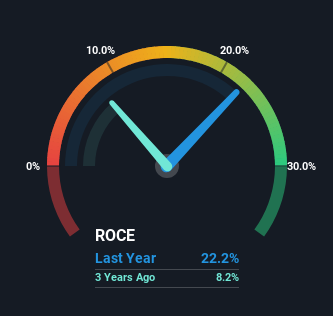If you're not sure where to start when looking for the next multi-bagger, there are a few key trends you should keep an eye out for. Amongst other things, we'll want to see two things; firstly, a growing return on capital employed (ROCE) and secondly, an expansion in the company's amount of capital employed. Put simply, these types of businesses are compounding machines, meaning they are continually reinvesting their earnings at ever-higher rates of return. And in light of that, the trends we're seeing at Kanematsu's (TSE:8020) look very promising so lets take a look.
Understanding Return On Capital Employed (ROCE)
For those who don't know, ROCE is a measure of a company's yearly pre-tax profit (its return), relative to the capital employed in the business. Analysts use this formula to calculate it for Kanematsu:
Return on Capital Employed = Earnings Before Interest and Tax (EBIT) ÷ (Total Assets - Current Liabilities)
0.22 = JP¥72b ÷ (JP¥728b - JP¥402b) (Based on the trailing twelve months to June 2024).
So, Kanematsu has an ROCE of 22%. In absolute terms that's a great return and it's even better than the Trade Distributors industry average of 7.4%.
Check out our latest analysis for Kanematsu

In the above chart we have measured Kanematsu's prior ROCE against its prior performance, but the future is arguably more important. If you're interested, you can view the analysts predictions in our free analyst report for Kanematsu .
What Can We Tell From Kanematsu's ROCE Trend?
We like the trends that we're seeing from Kanematsu. The numbers show that in the last five years, the returns generated on capital employed have grown considerably to 22%. The amount of capital employed has increased too, by 32%. So we're very much inspired by what we're seeing at Kanematsu thanks to its ability to profitably reinvest capital.
On a separate but related note, it's important to know that Kanematsu has a current liabilities to total assets ratio of 55%, which we'd consider pretty high. This effectively means that suppliers (or short-term creditors) are funding a large portion of the business, so just be aware that this can introduce some elements of risk. Ideally we'd like to see this reduce as that would mean fewer obligations bearing risks.
In Conclusion...
A company that is growing its returns on capital and can consistently reinvest in itself is a highly sought after trait, and that's what Kanematsu has. Since the stock has returned a staggering 129% to shareholders over the last five years, it looks like investors are recognizing these changes. In light of that, we think it's worth looking further into this stock because if Kanematsu can keep these trends up, it could have a bright future ahead.
If you want to know some of the risks facing Kanematsu we've found 2 warning signs (1 is significant!) that you should be aware of before investing here.
Kanematsu is not the only stock earning high returns. If you'd like to see more, check out our free list of companies earning high returns on equity with solid fundamentals.
Valuation is complex, but we're here to simplify it.
Discover if Kanematsu might be undervalued or overvalued with our detailed analysis, featuring fair value estimates, potential risks, dividends, insider trades, and its financial condition.
Access Free AnalysisHave feedback on this article? Concerned about the content? Get in touch with us directly. Alternatively, email editorial-team (at) simplywallst.com.
This article by Simply Wall St is general in nature. We provide commentary based on historical data and analyst forecasts only using an unbiased methodology and our articles are not intended to be financial advice. It does not constitute a recommendation to buy or sell any stock, and does not take account of your objectives, or your financial situation. We aim to bring you long-term focused analysis driven by fundamental data. Note that our analysis may not factor in the latest price-sensitive company announcements or qualitative material. Simply Wall St has no position in any stocks mentioned.
About TSE:8020
Established dividend payer with proven track record.
Market Insights
Community Narratives




